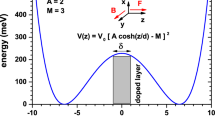Abstract
We report the inclusion of temperature effects on the Mahan-Nozières-De Dominicis framework to study both many-body and temperature effects in photoluminescence spectra of doped semiconductors. The electronic part of the correlation function characterizes the photoluminescence spectra. We have treated the optical valence hole as a localized scattering potential center and studied effects of the electron-hole interaction enhancement on the photoluminescence spectra leading to the appearance of shake-up structures. We also have identified a term in the correlation function which represents the finite-temperature contribution to the intensities of the shake-up structures. The method is used to study the magnetophotoluminescence of modulation-doped quantum wells with a weak periodic lateral potential.
Similar content being viewed by others
Author information
Authors and Affiliations
Corresponding author
Rights and permissions
About this article
Cite this article
Tavares, M., Marques, G.E. & Tejedor, C. The finite-temperature photoluminescence correlation function in semiconductor heterostructures. Eur. Phys. J. B 11, 655–663 (1999). https://doi.org/10.1007/s100510051194
Received:
Revised:
Published:
Issue Date:
DOI: https://doi.org/10.1007/s100510051194




